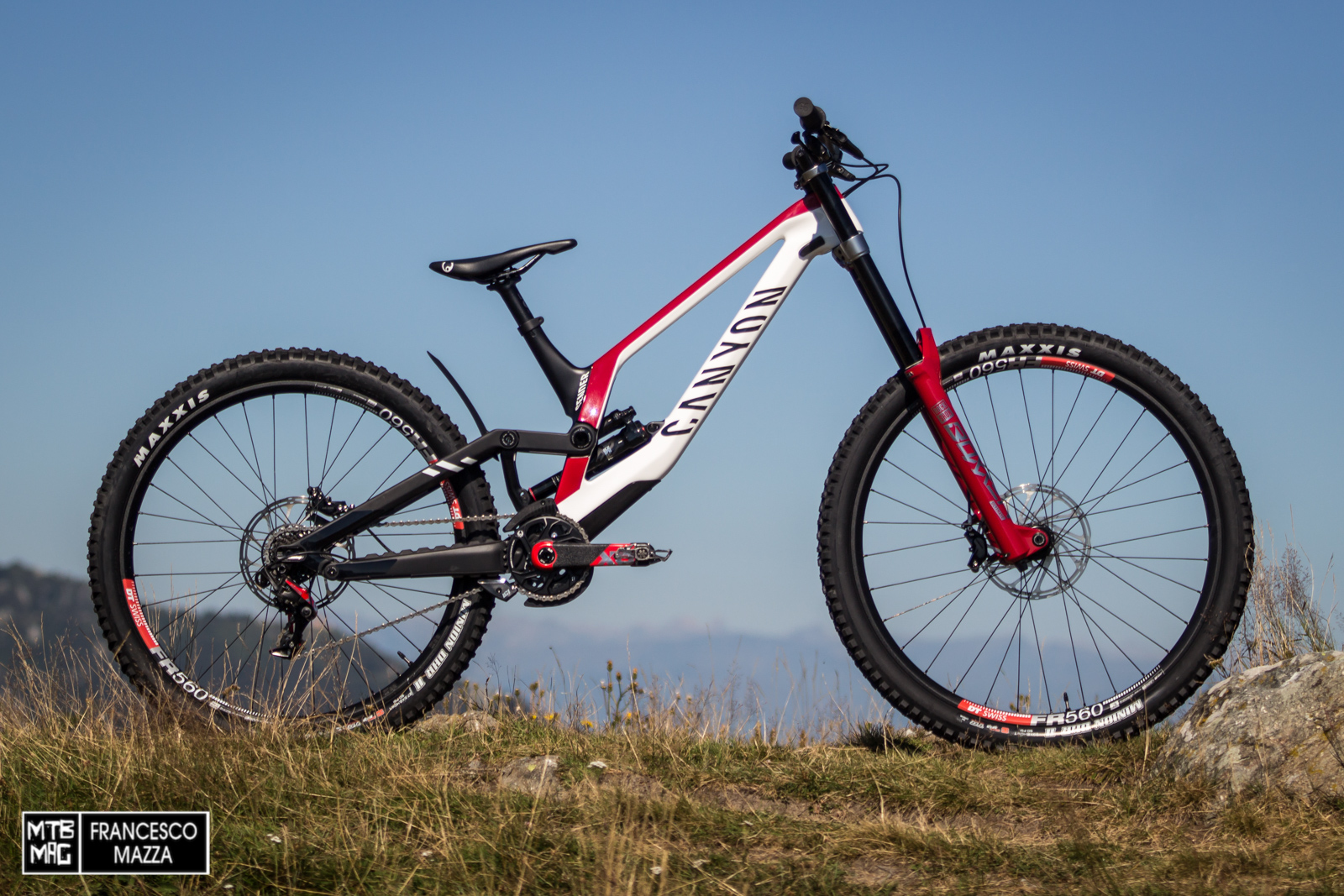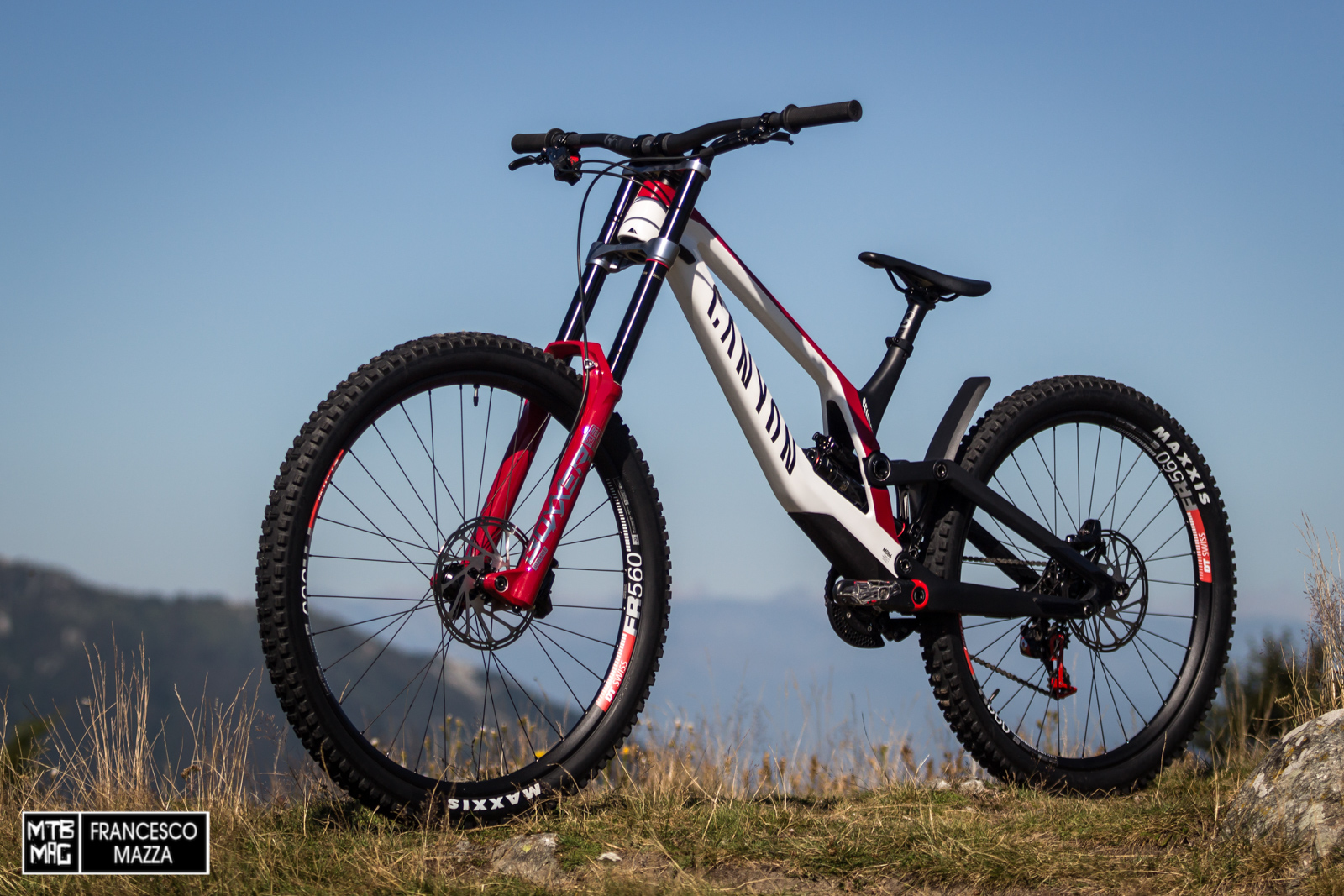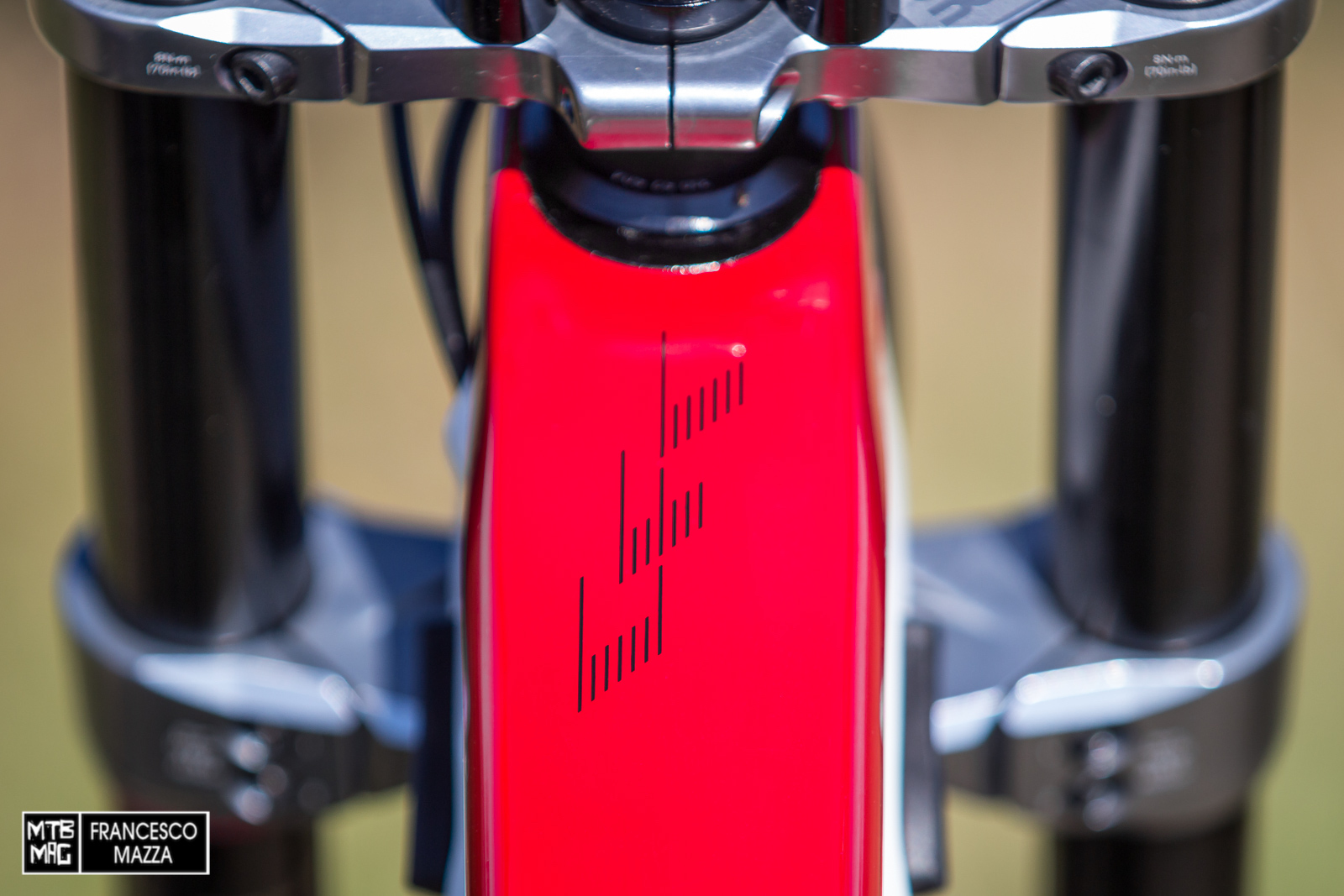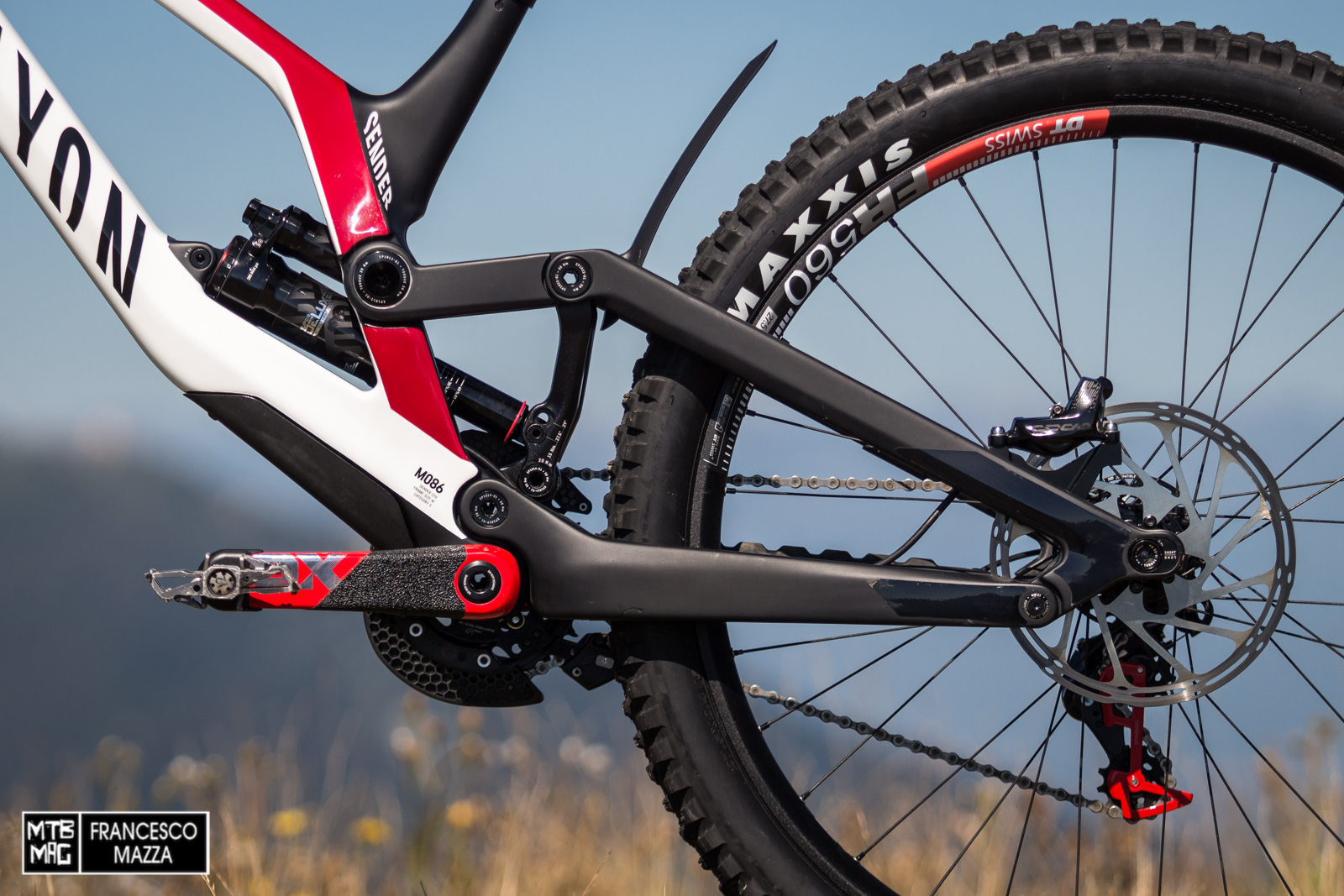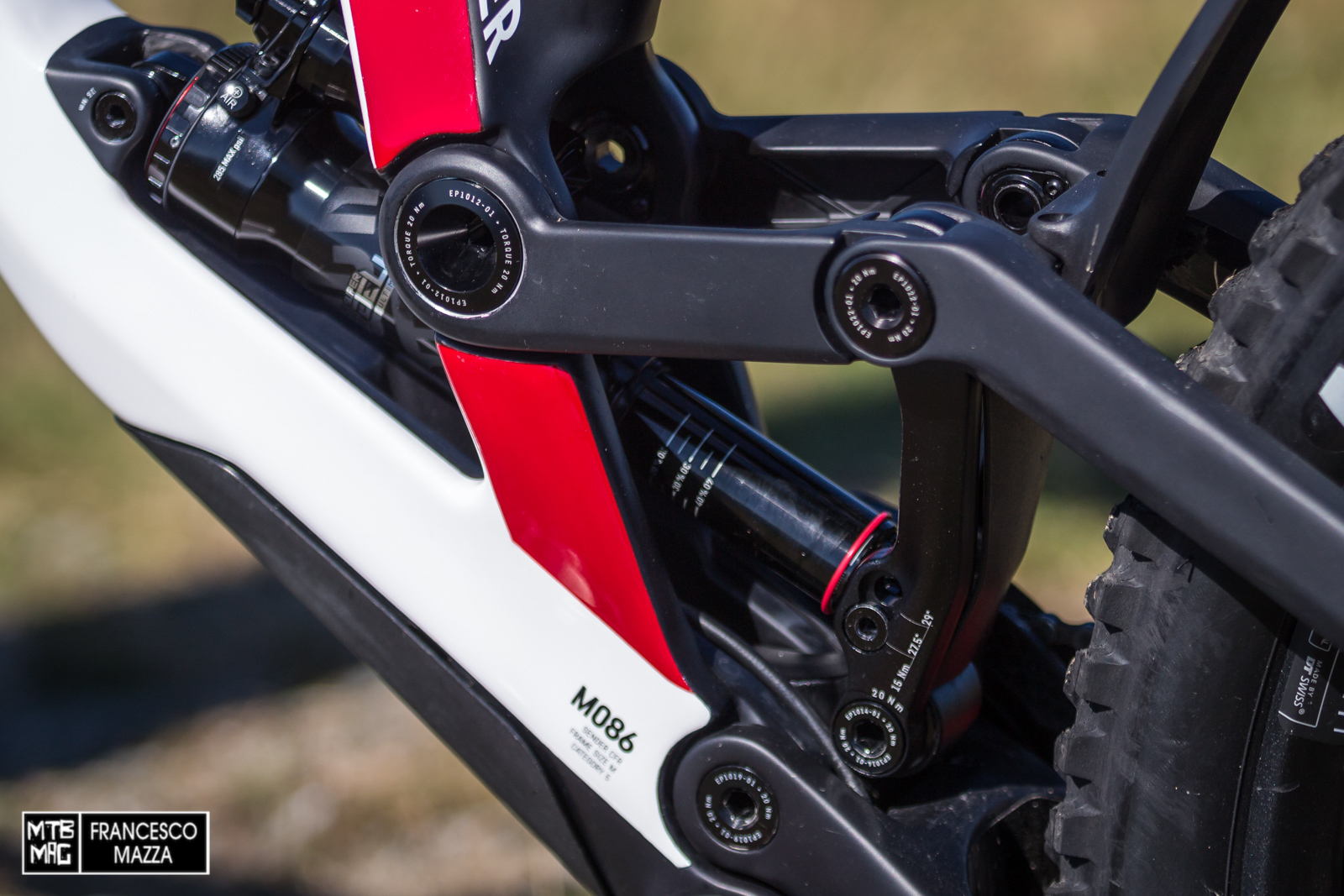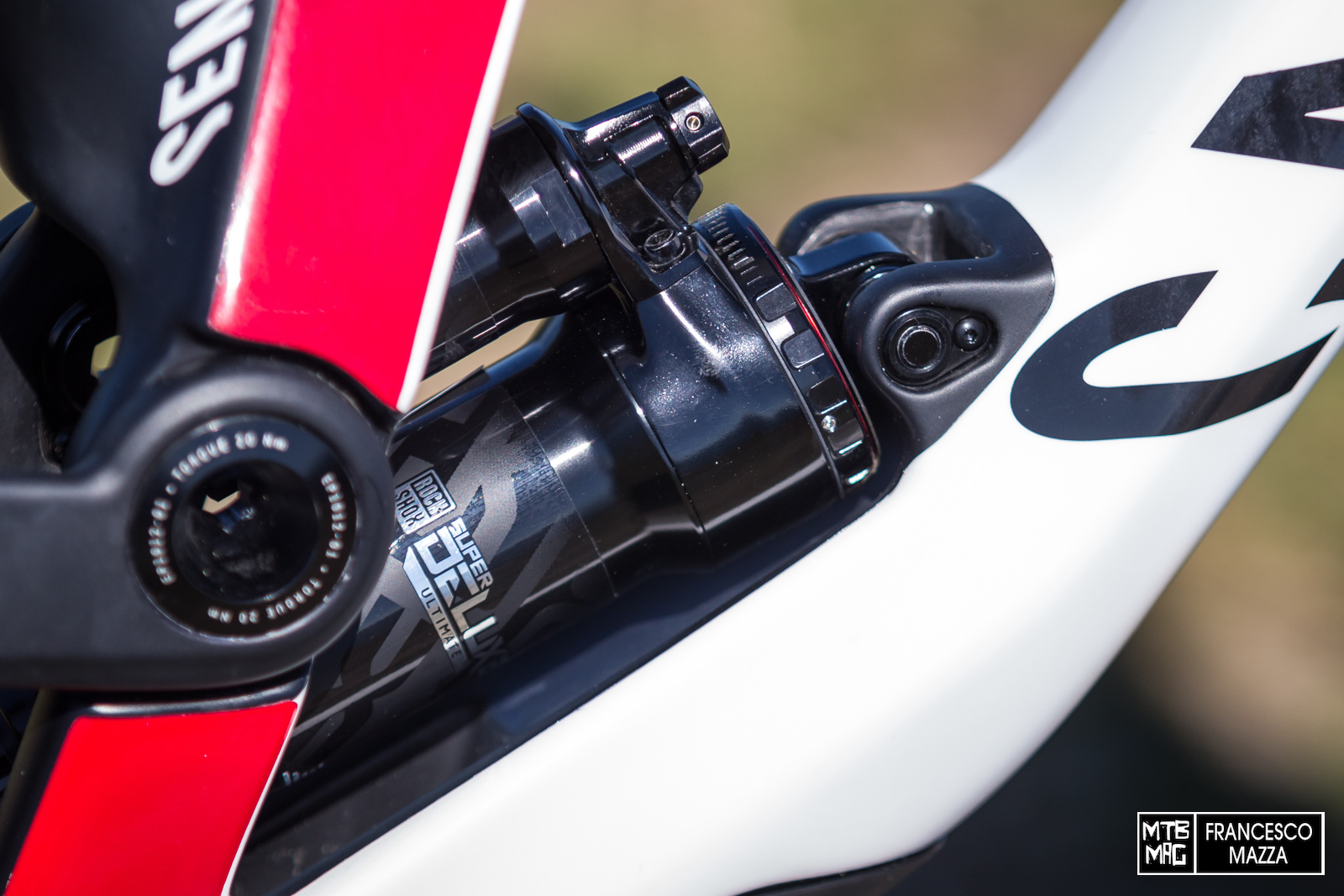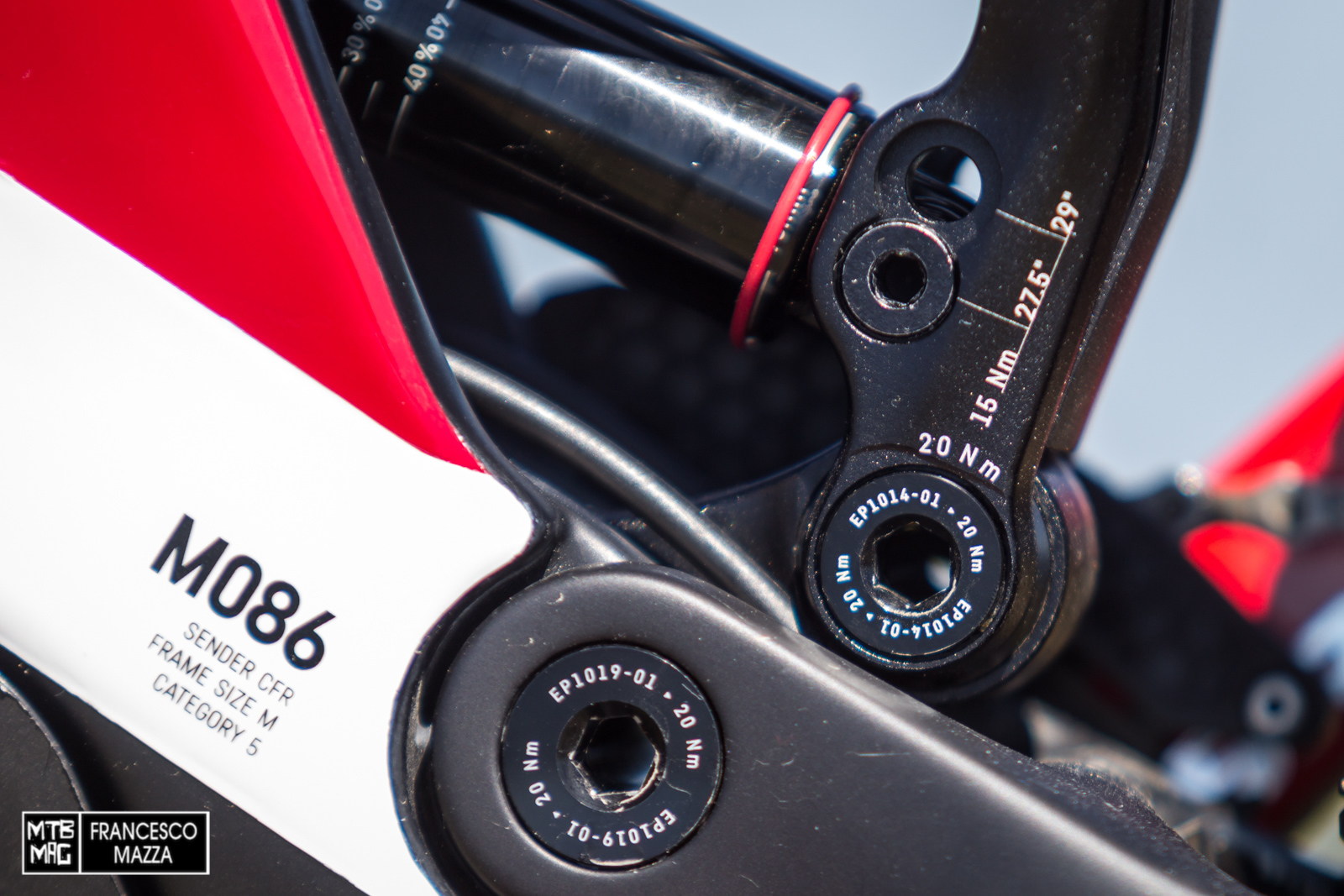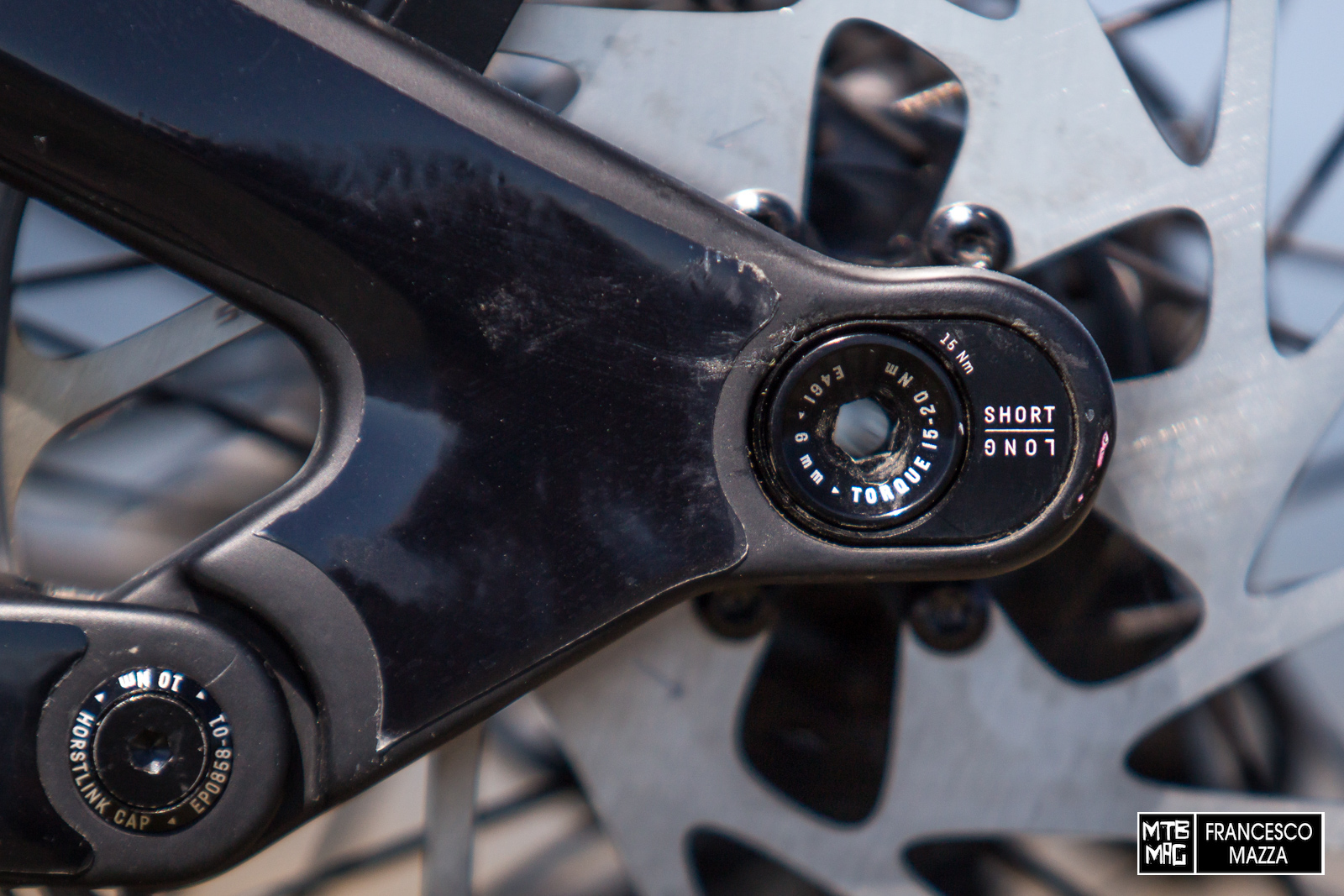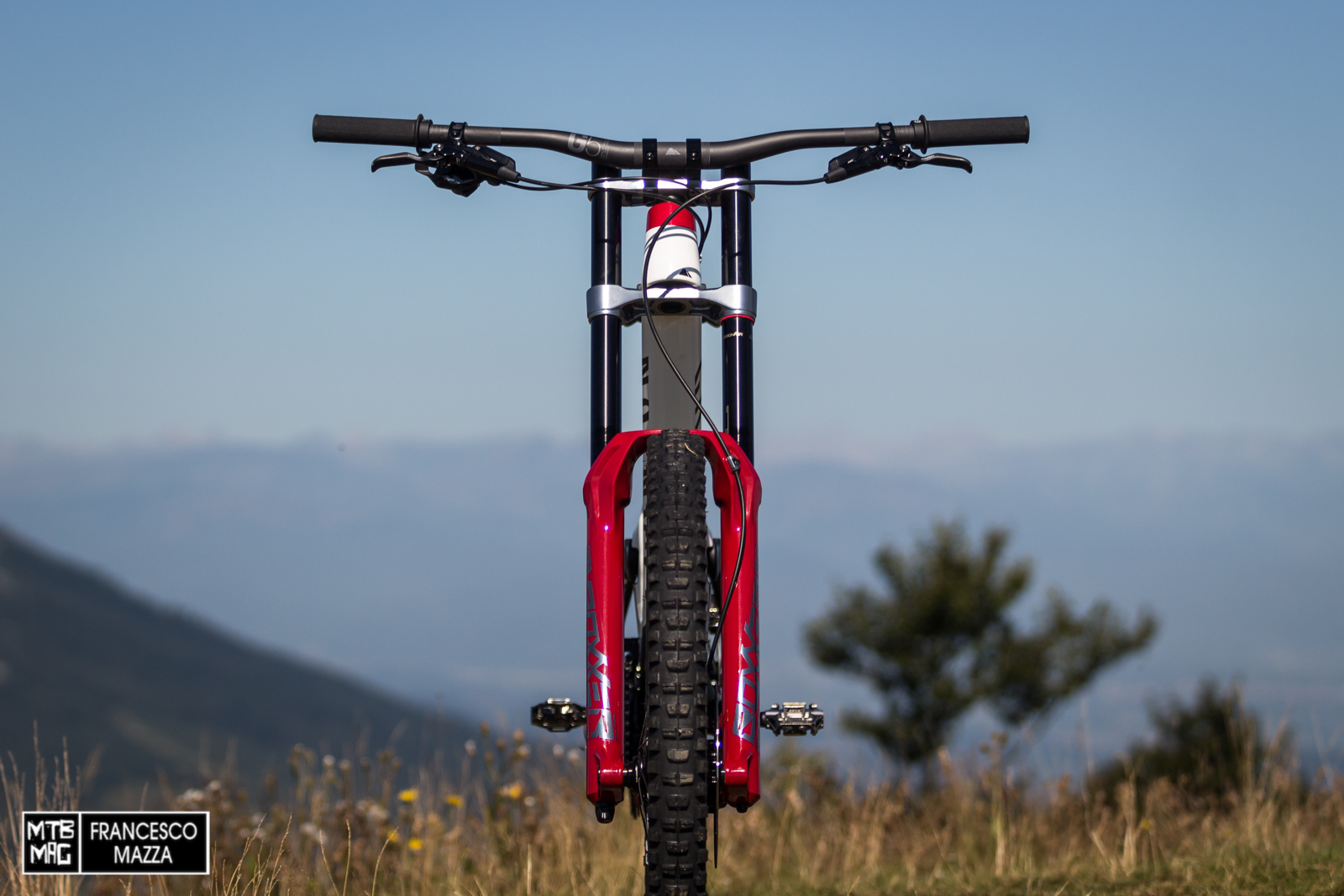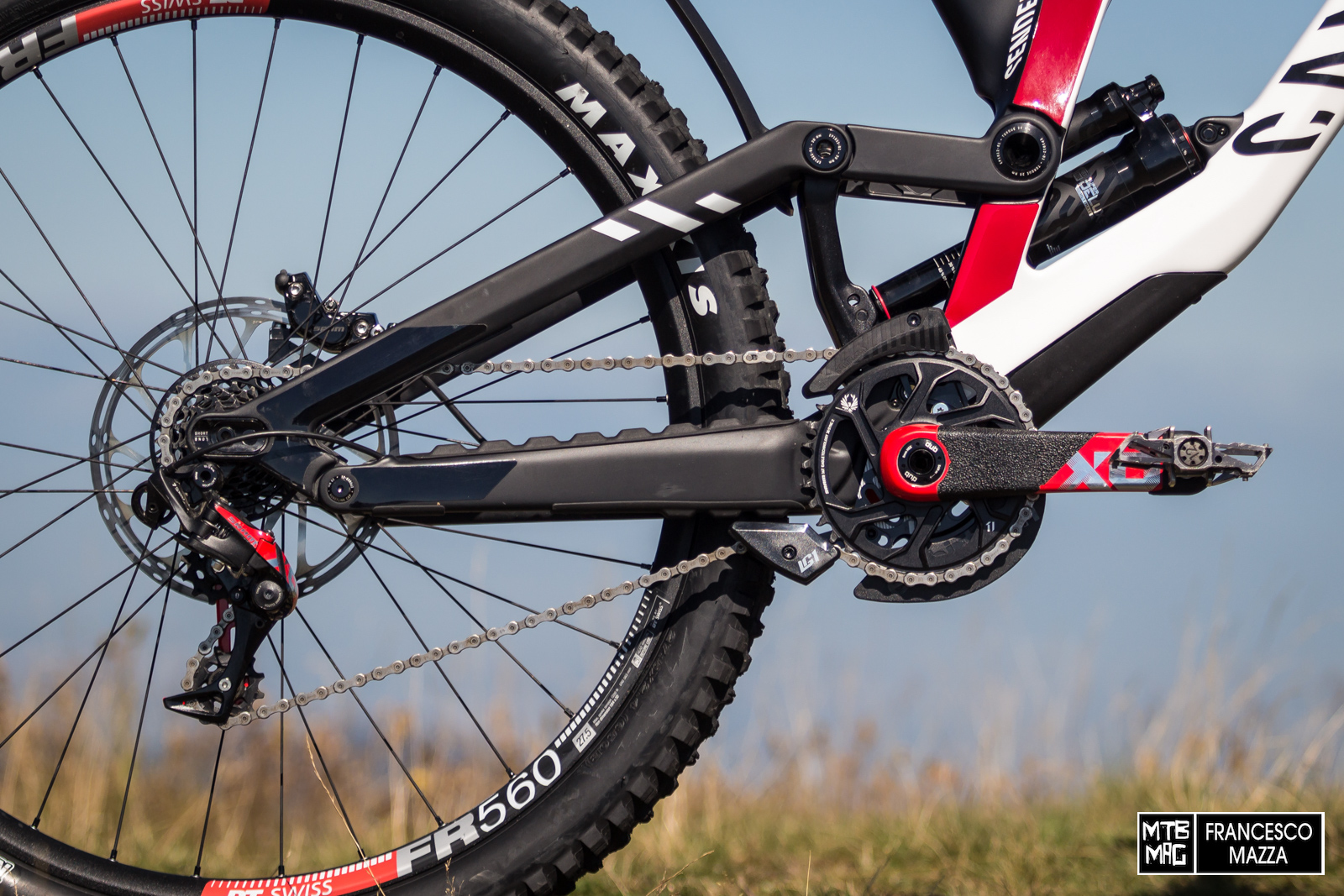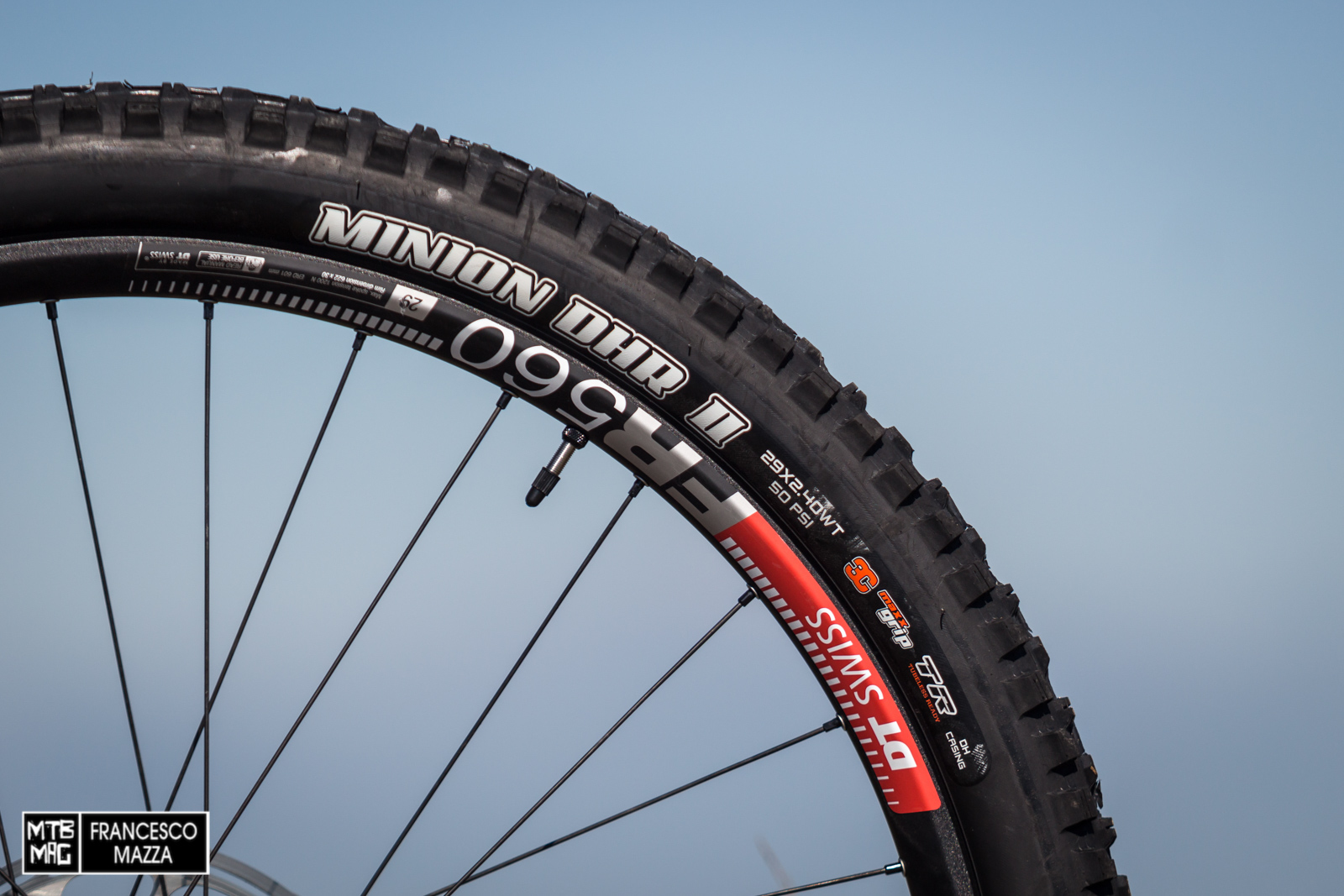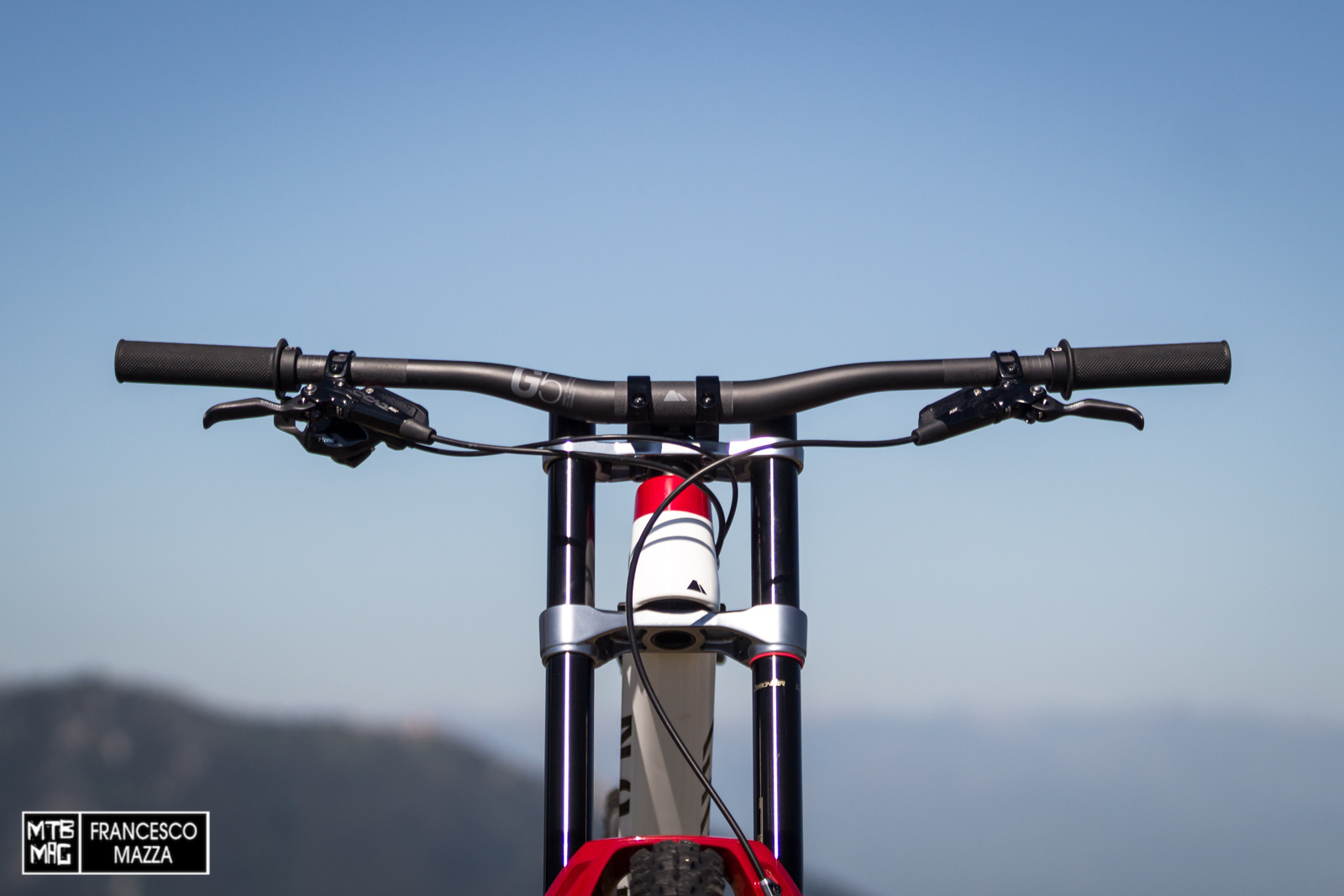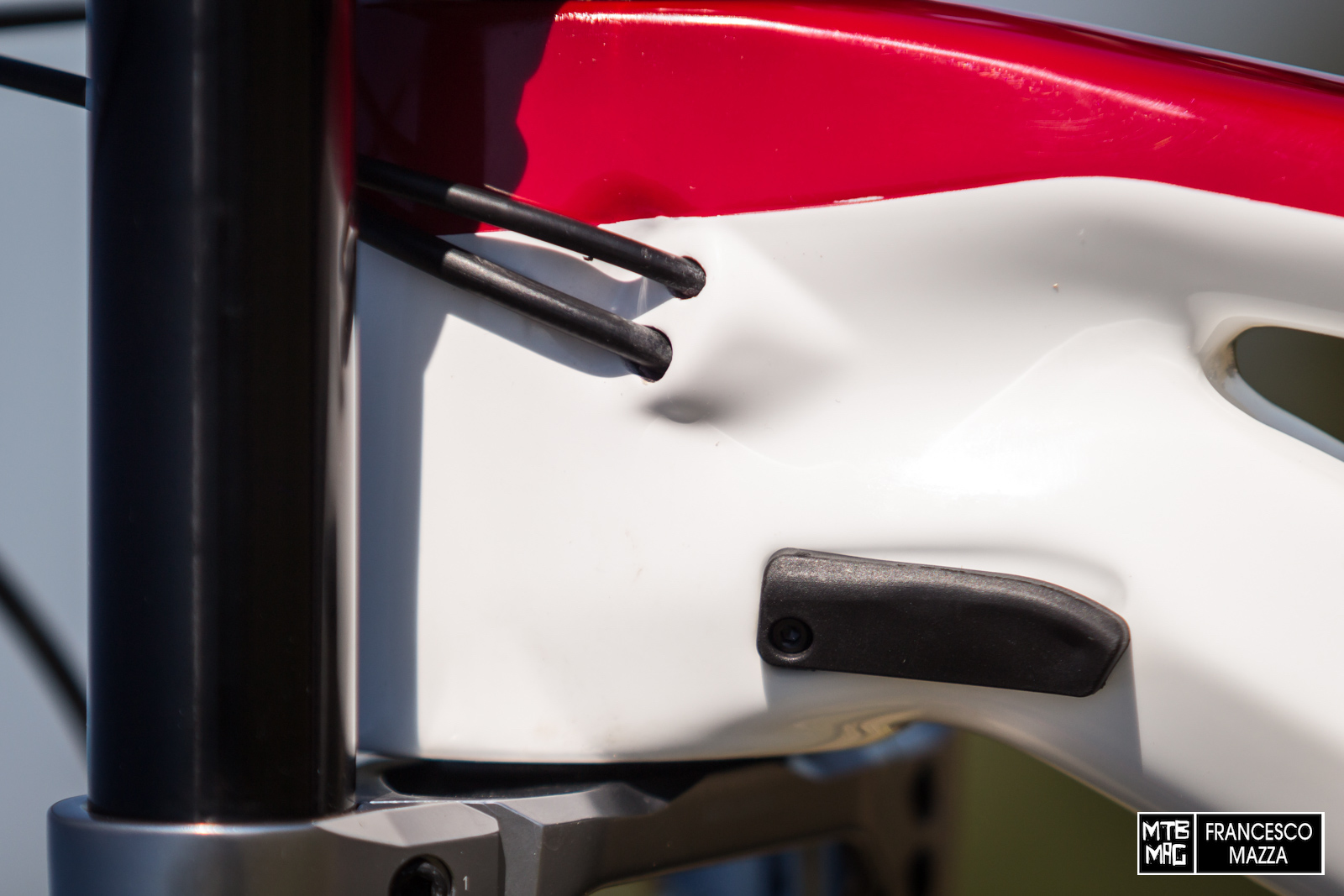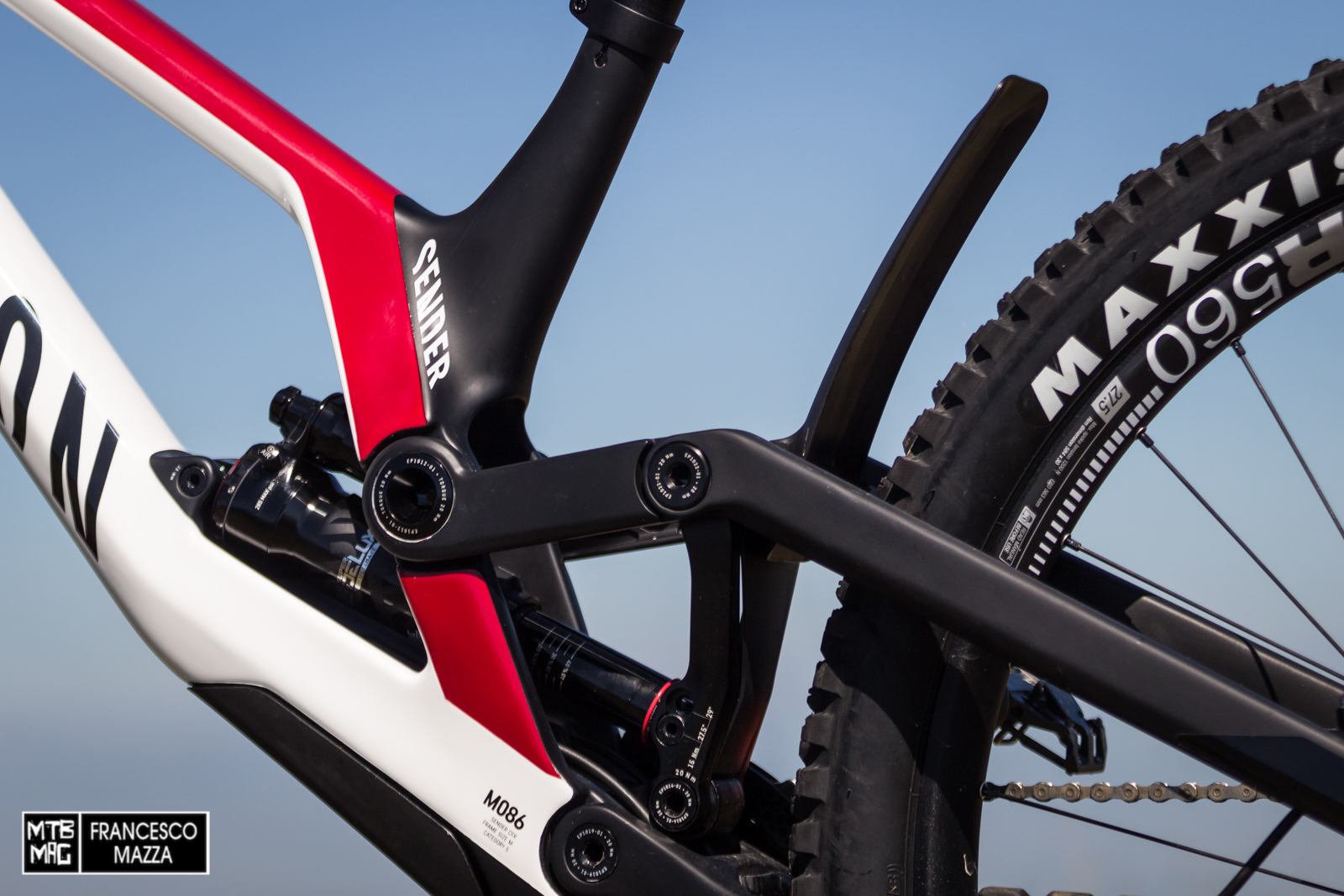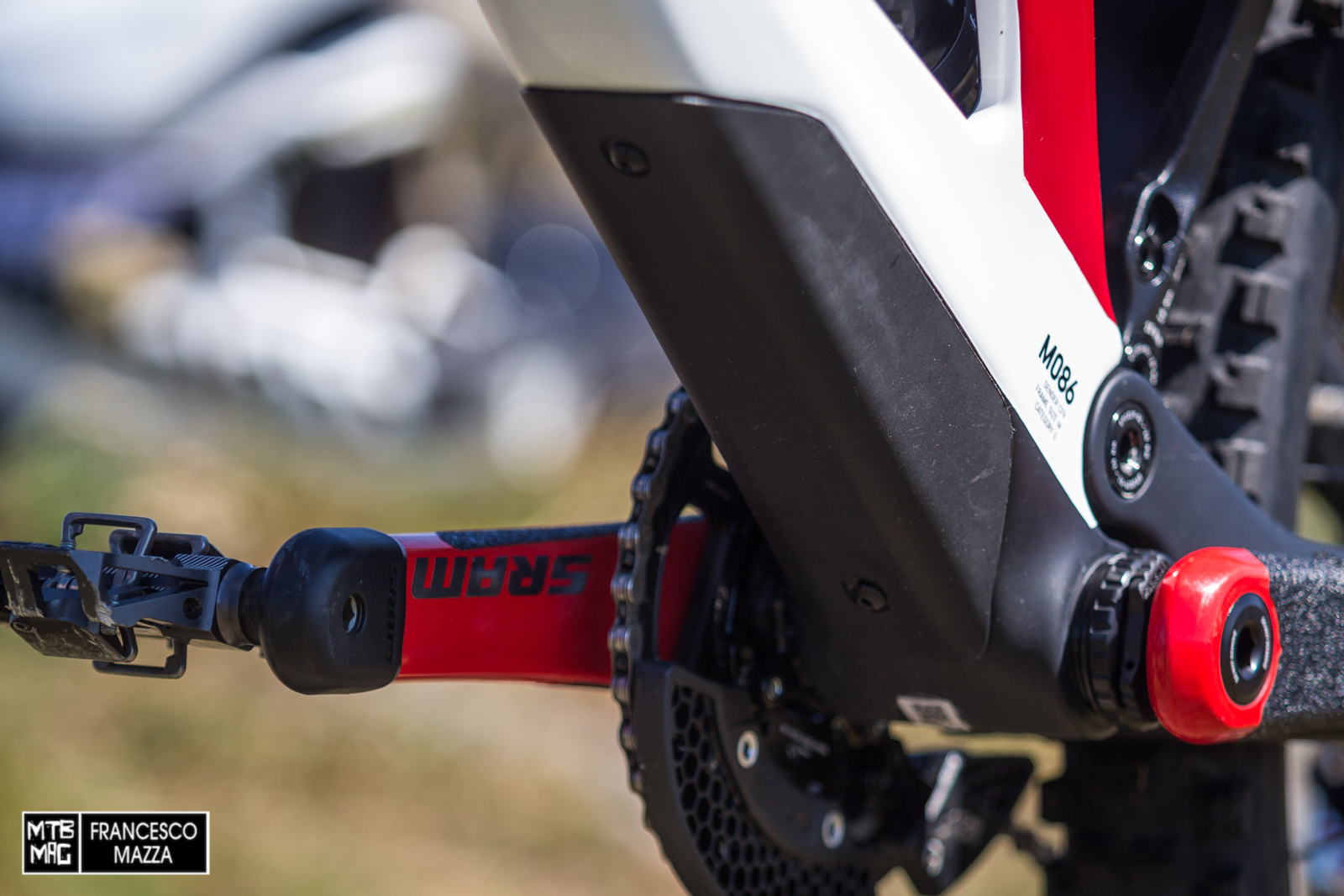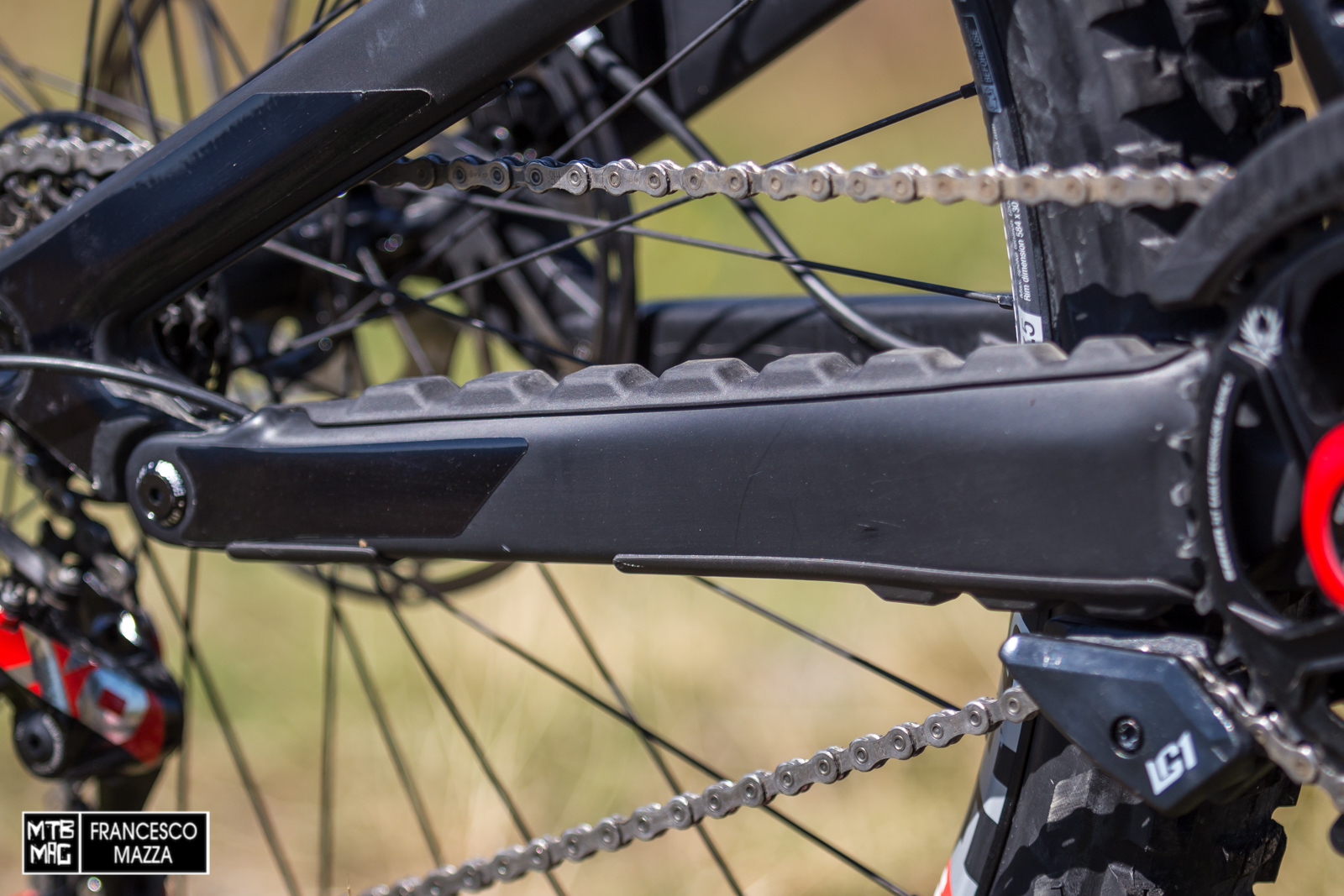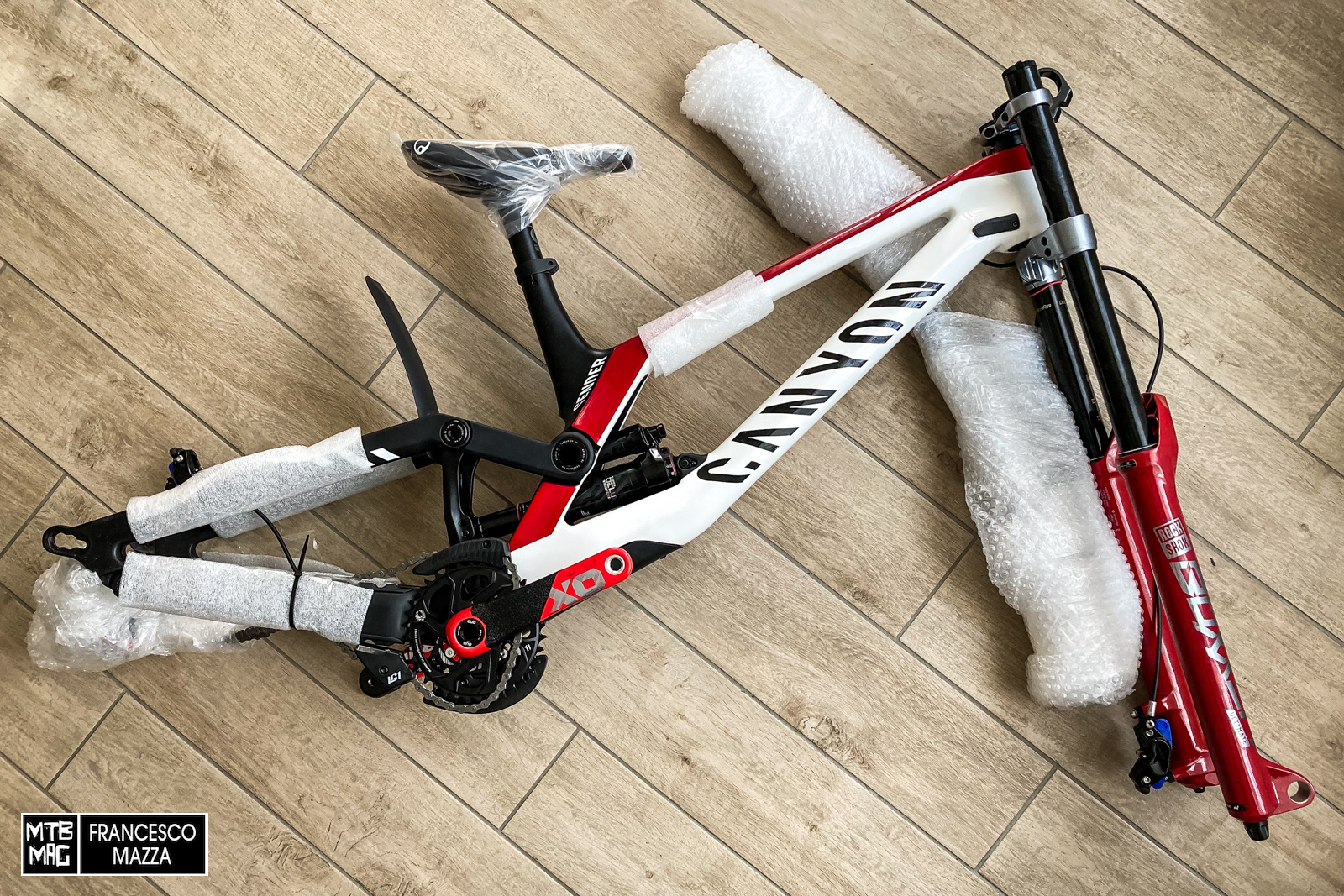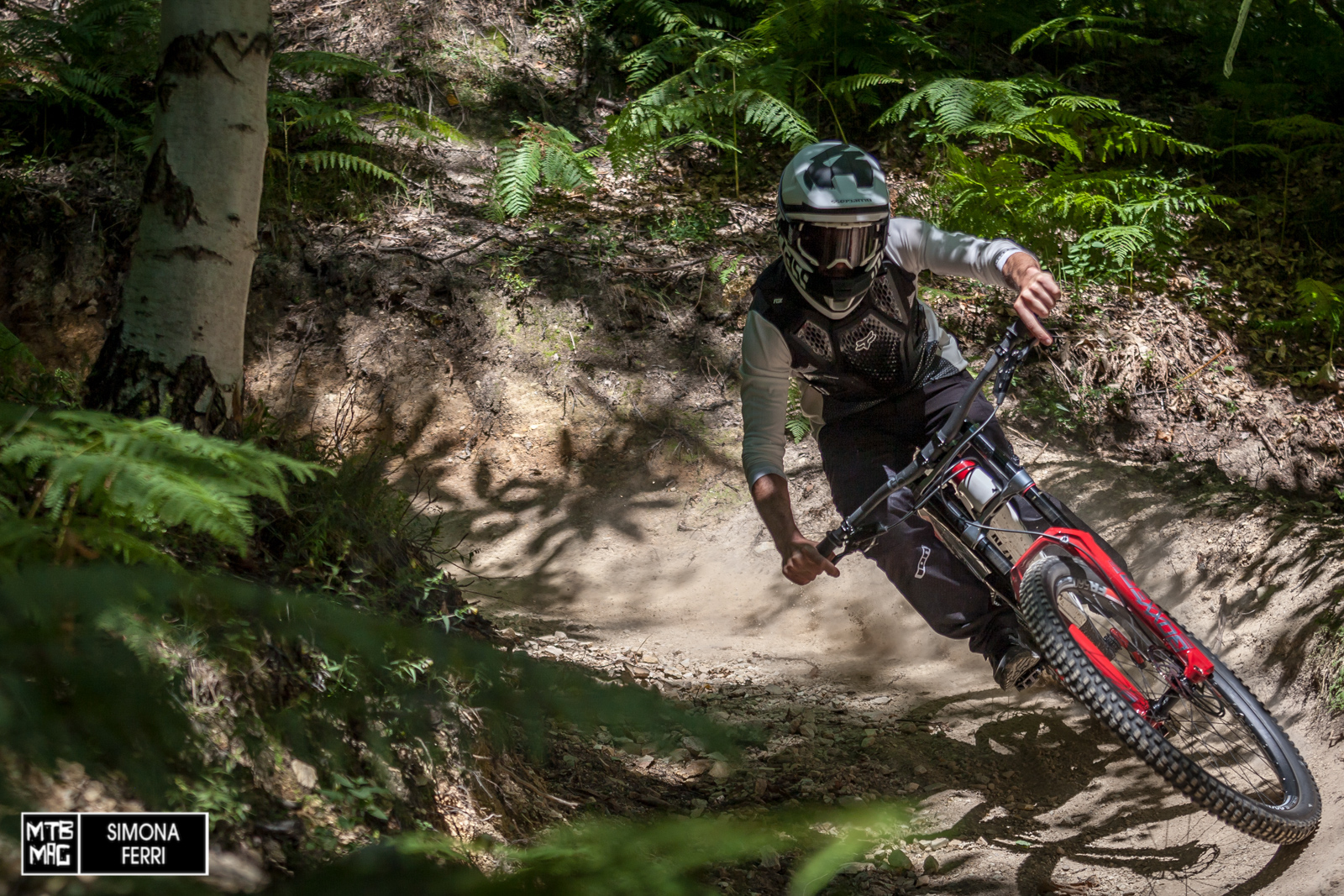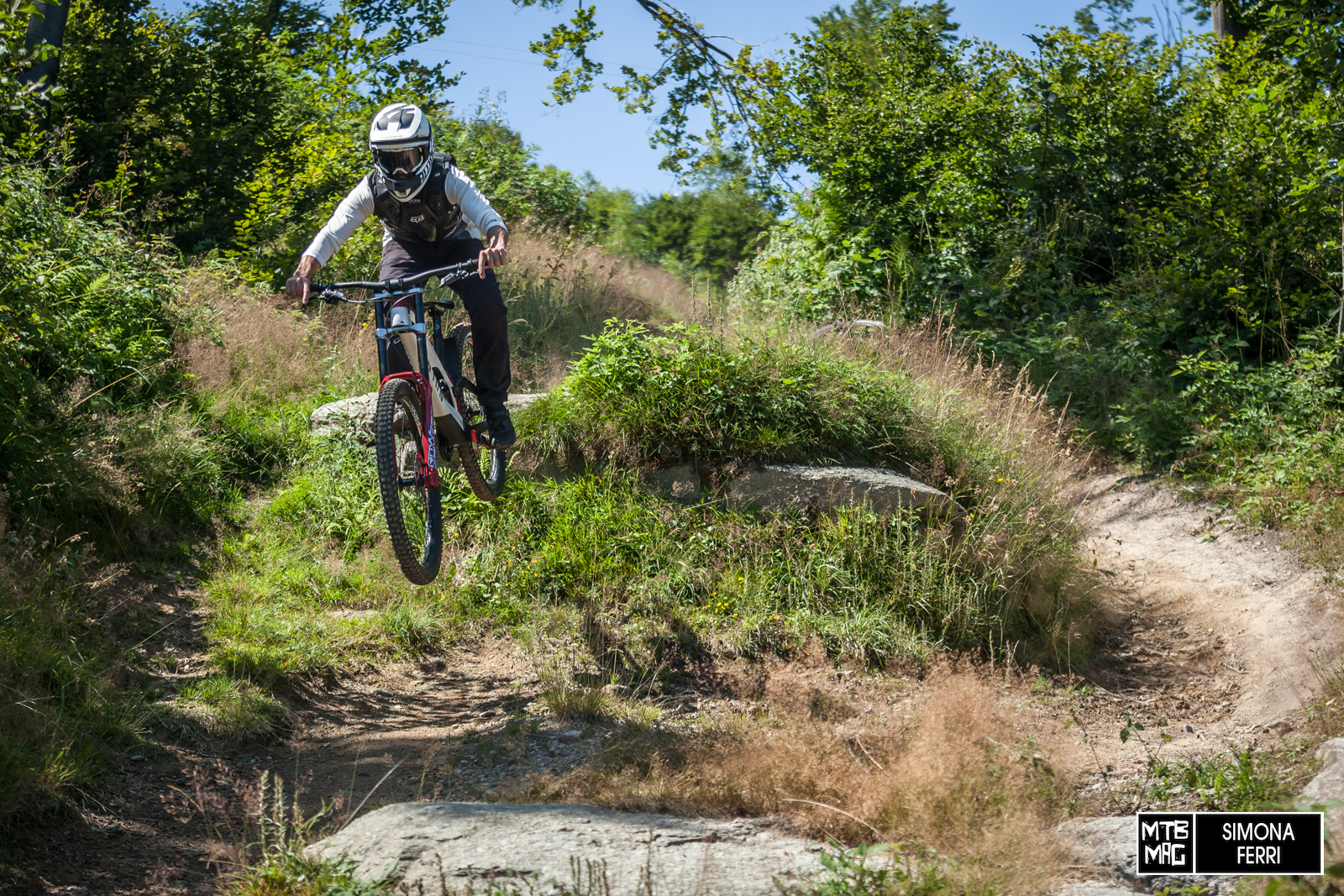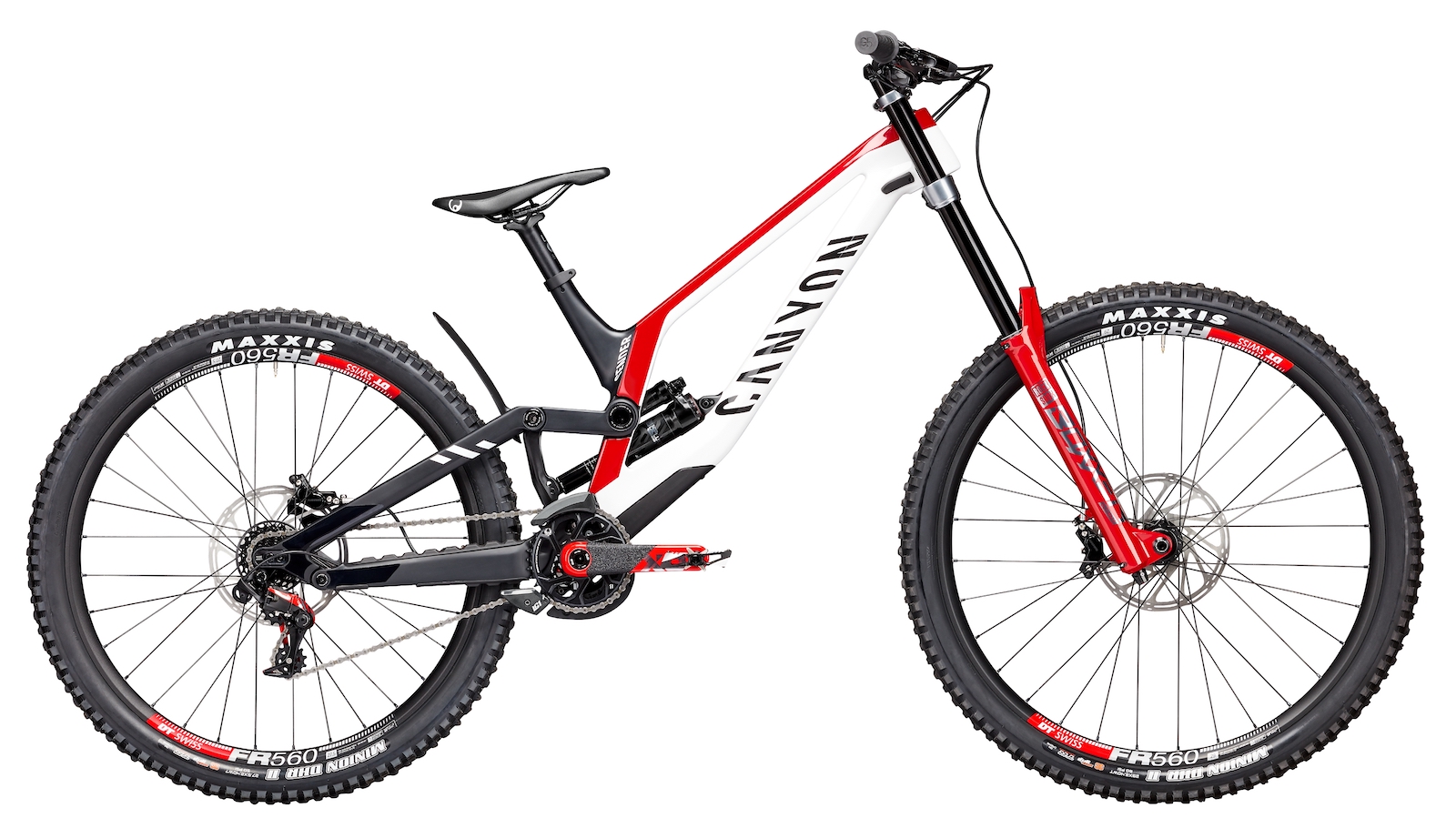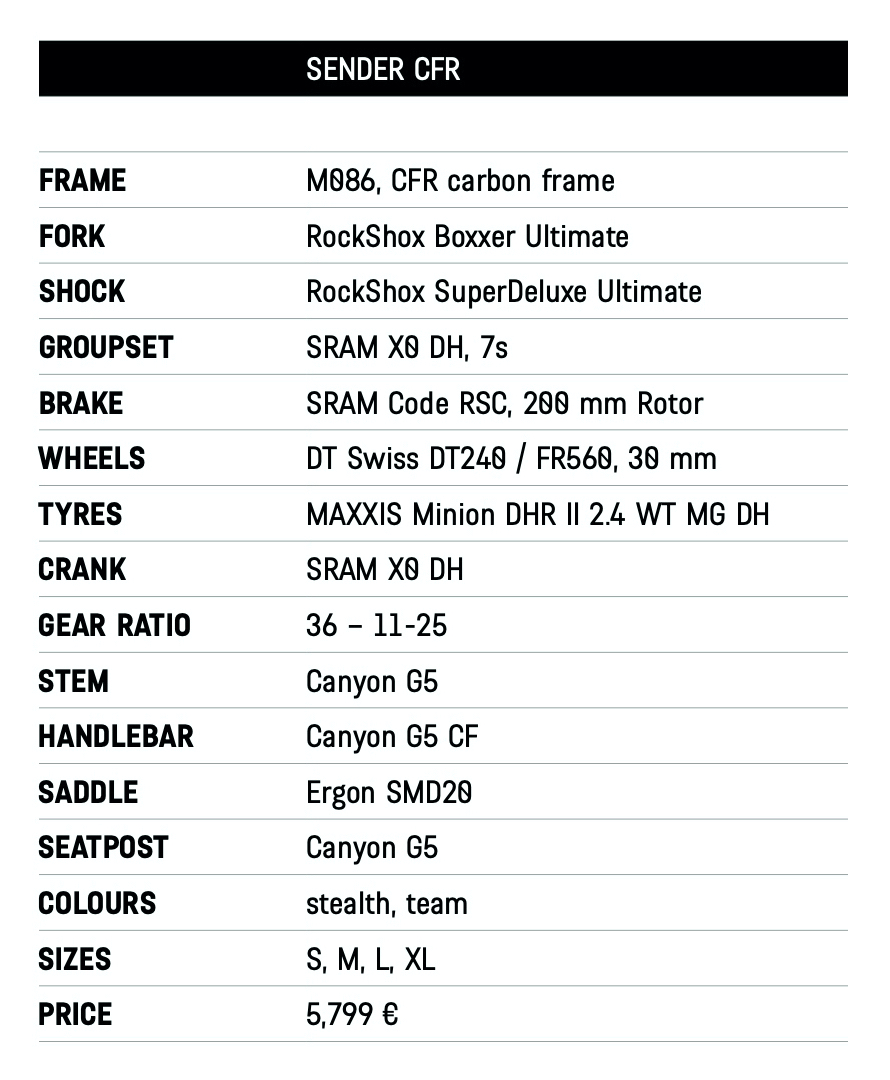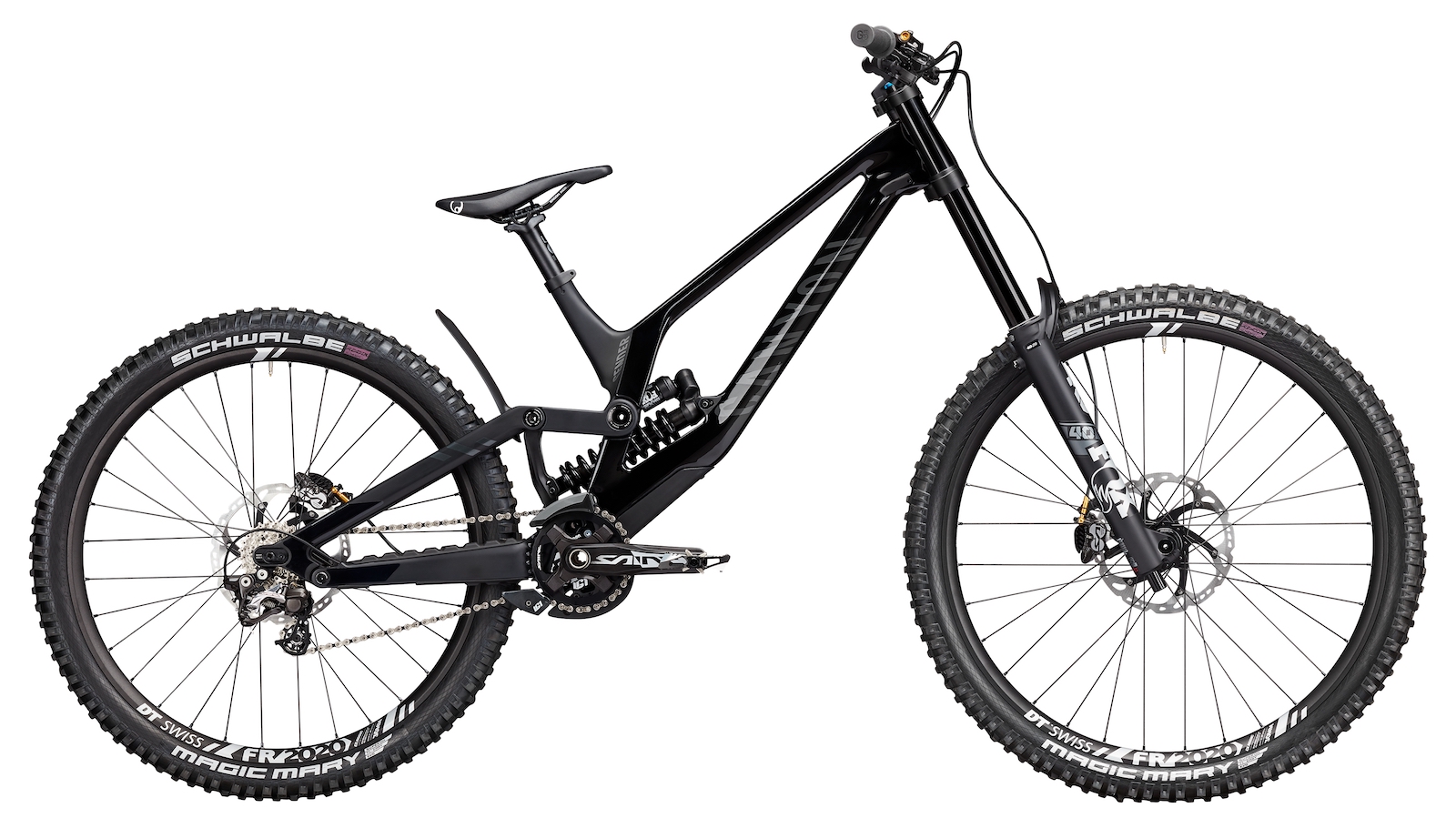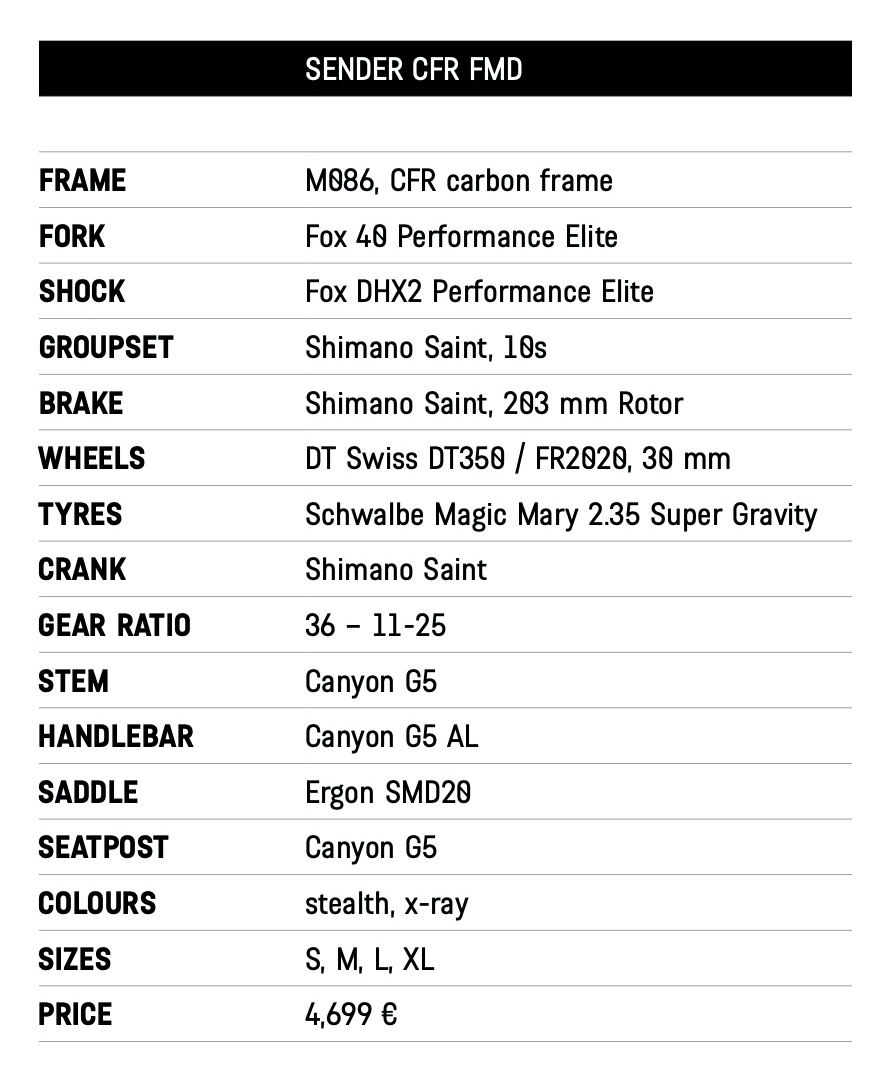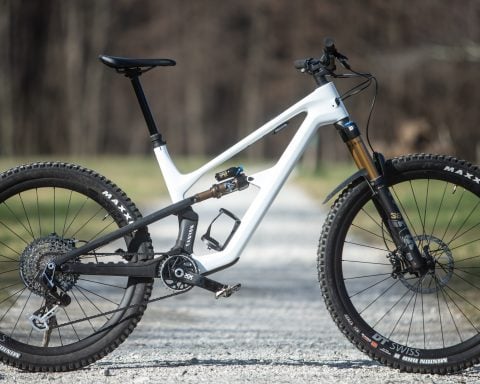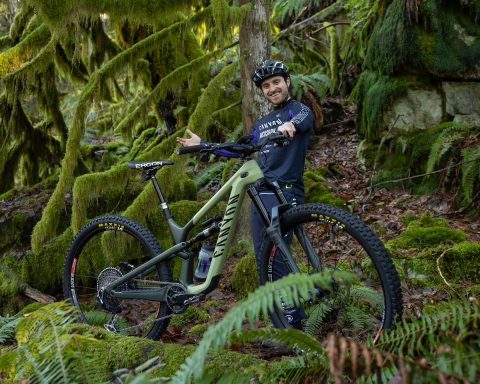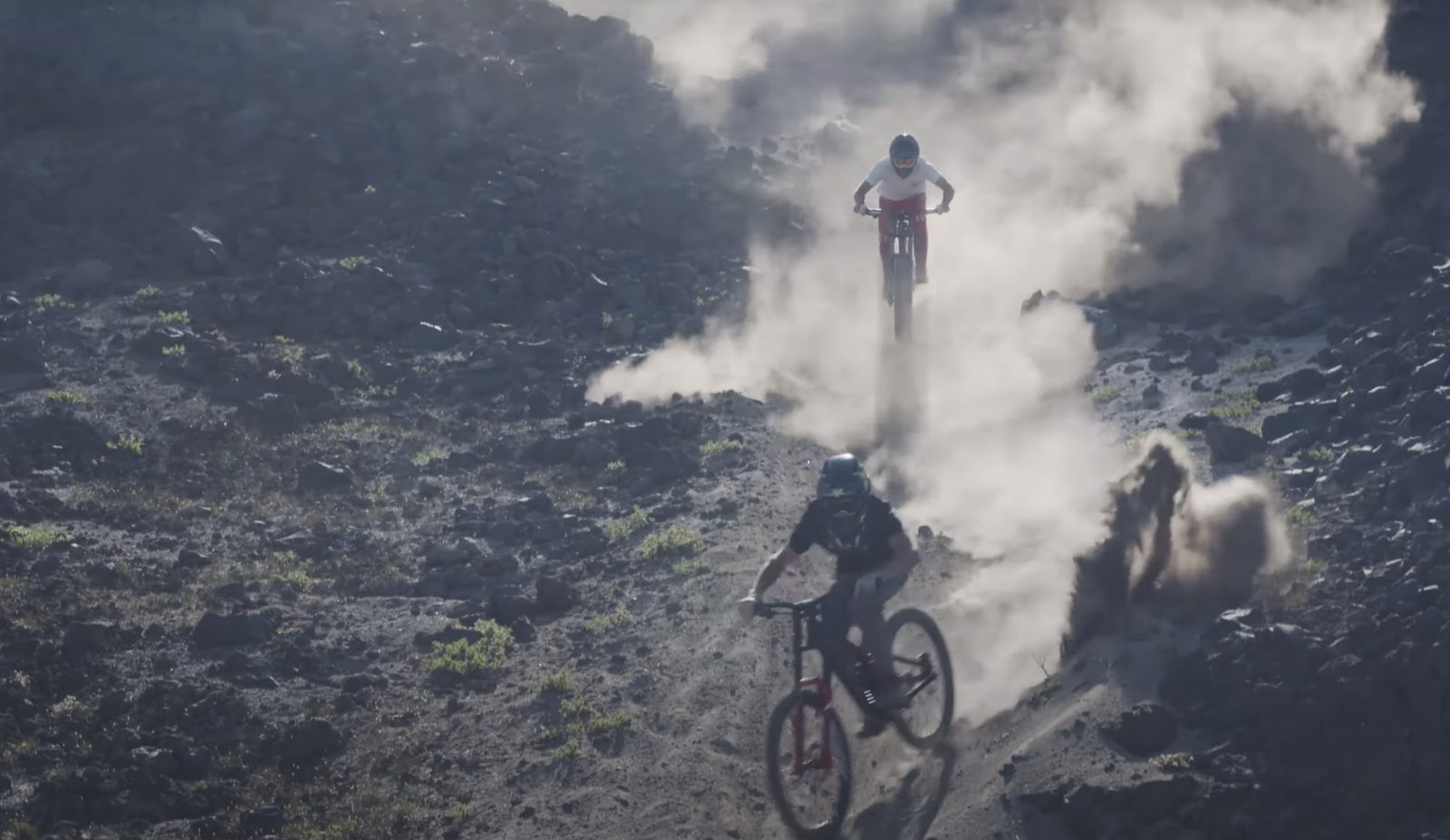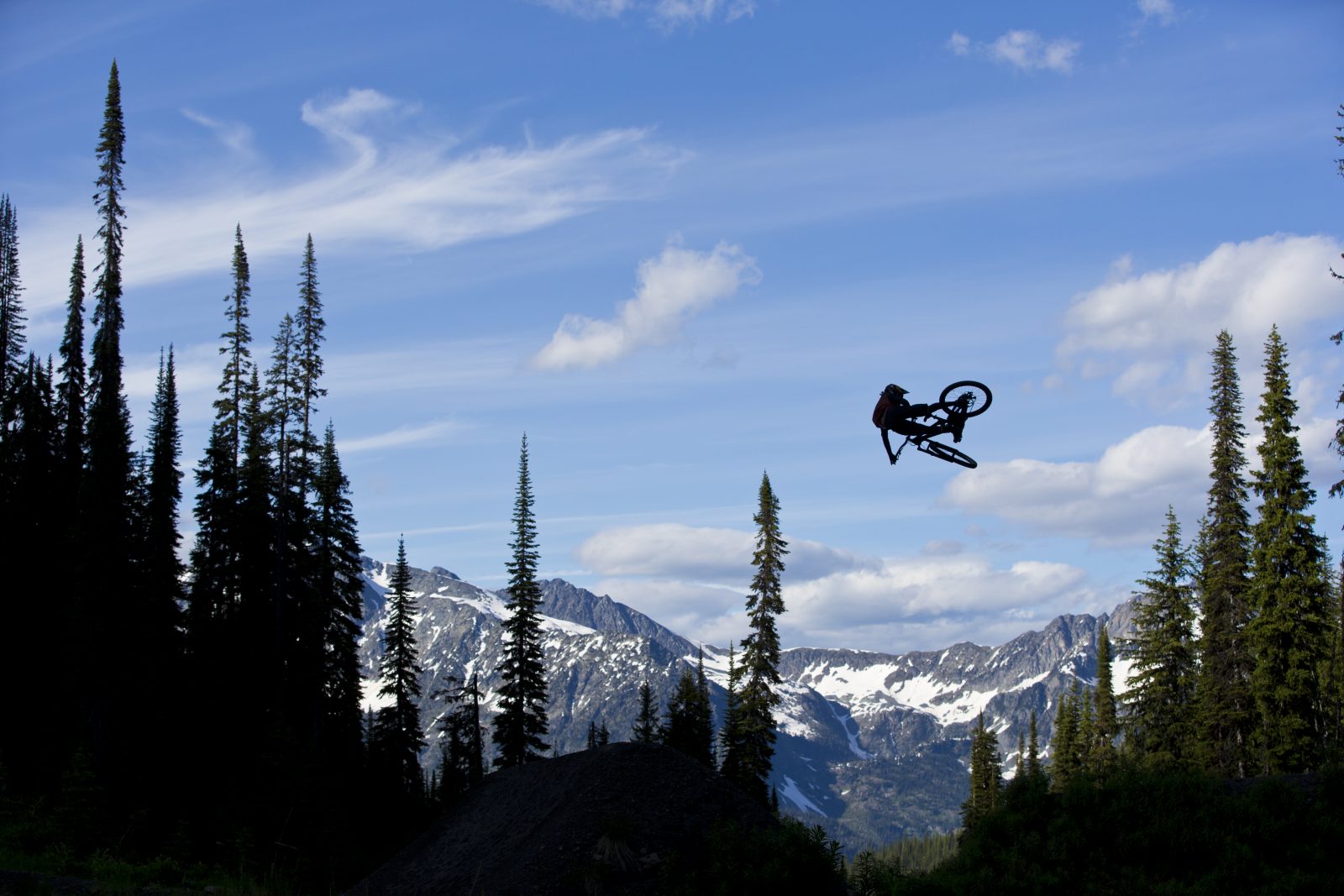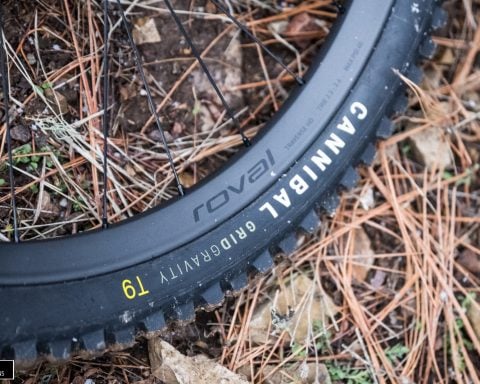The start date of the postponed 2020 UCI DH World Cup season is almost upon us, finally, and Canyon has used the time available to wrap up the development and release their new DH weapon that’s already in the hands of the Canyon Factory Racing teams and FMD Racing. After about two years of R&D led by the same engineer who created the first Sender model in 2016, making use of the constant interaction with the World Cup athletes and mechanics, today the Koblenz brand presents the brand new Sender CFR.
Canyon has sent us a sample of the new Sender CFR to delve as much as possible into the details of this new race ready machine and to report our riding impressions. Thanks to the hospitality of the Hotel Alpino I was able to put it to the test on the various trails of the bike park in the Monte Alpet Bike Village, which are well-kept, fun and sufficiently technical for a bike of this level. The set-up that Canyon chose for us was the top of the line, equipped entirely with RockShox suspension and SRAM components, but an alternative set-up is also available with Fox Performance Elite suspension and a Shimano Saint group.
Details
- Frame material: carbon fiber
- Wheel size: 29 / 27.5 “(S and M) – 29” (L and XL)
- Adjustable geometry: yes
- Front travel: 200mm
- Rear travel: 200mm
- Rear shock specs: 250mm × 75mm
- Fork offset: 56mm
- Drivetrain: 1 × 7 (36t / 11-25)
- Availability as frameset only: no
- Claimed weight: 15.8kg / 3.2kg frame
- Measured weight: 15,65kg (with Tubeless wheels / without pedals)
The new Sender CFR was born from the search for maximum performance for athletes of the caliber of Troy Brosnan. From behind an aesthetic very similar to that of the previous model there are an infinite number of innovations, updates and tricks that have been developed directly thanks to experience in World Cup. The new frame is lighter, more reliable, better performing, has a new suspension system and finally, the feature that certainly affects the character of the new Sender the most, uses the 29-inch wheel format for sizes L and XL and mullet for sizes S and M. Let’s explore the details.
CFR stands for Canyon Factory Racing, underlining the absolutely race intended use of the new Sender. The construction of the frame is totally entrusted to carbon, including the entire rear end and the connecting rod of the suspension system which on the previous model was made of aluminum. The arrangement of the fibers, the thicknesses, the type of fibers and the resins have been carefully selected to increase the strength while decreasing the weight by over 600 grams compared to the frame of the old model. Several details also contributed to this weight reduction, including, in the first place, the new upper shock mount on the down tube, instead of on the top tube.
This new shock position made the increased strength and decreased weight possible, since the frame is subjected to less stress. In addition, this solution further lowers the center of gravity of the bike which lends toward a general improvement of its handling. In addition to the new position of the rear shock, the kinematic system has been completely redesigned, again based on a Horst link, with a pivot point optimized to reduce pedal kickback by 60% along with a new linkage driving the rear shock, thanks to which the Sender CFR achieves a more progressive compression curve, again based on Canyon’s well-known Triple Phase concept: initial sensitivity, mid-stroke support and end progressivity.
The connecting rods rotate on pivots equipped with sealed ball bearings and being entirely in carbon, they are equipped with threaded aluminum seats, which are replaceable in case the thread should be damaged following the frequent disassembly to which the bikes are subjected in the paddocks of the races.
The upper shock mount hardware also has a replaceable threaded seat. The shock eyelet seats are wider to accommodate the new hardware used by both RockShox and Fox which include ball bearings. The down tube area below the shock has a concave shape that creates room for the shock.
The lower shock mount is anchored directly to the linkage rod where we find two options, one marked 27.5″ and the other 29″. Based on where the shock is fixed, the bike geometry is optimized for one wheel size rather than the other. It should be noted that, although this option is present on the linkages of all sizes, it can only be used on sizes L and XL. These two sizes, sold with 29″ wheels both at the front and at the rear, are the only ones on which you can choose to change the size of the rear wheel. The sizes S and M, on the other hand, are sold with 29″ wheels up front and 27.5″ at the rear, and cannot opt for the full 29″ format.
The Sender CFR also inherits from the previous model the possibility of adjusting the chainstay length through dedicated flip chips at the rear axle. Canyon has opted, however, for a variation of 10mm instead of the 16mm available on the previous Sender, to offer a more contained range and therefore more usability in both positions. I tried both positions and, although I generally prefer relatively long rear ends to balance modern geometry with a very long front end, for use mainly in bike parks I believe the short position is more suitable, while the long one is preferable on very fast DH tracks and steeper trails.
Through offset headset cups it is also possible to adjust the reach by. By replacing the standard centrally positioned cups, it is possible to obtain a dimension of 8mm longer or shorter depending on the mounting direction. This is a very useful option when you are between two sizes, or if you want to have a different riding position based on the tracks you face from time to time. Personally I found the reach in the standard position adequate for my height of 175cm which, according to the sizes recommended by Canyon, would be placed at the beginning of size M range, therefore ideally with a reach of -8mm.
The shock is a metric RockShox Super Deluxe Ultimate which comes standard with two volume spacers inside. Honestly, I was rather skeptical about the performance of this shock absorber, especially on a DH bike, but changed my mind very quickly and I had confirmation of it throughout the test as it proved to be sensitive, reliable and up to task, even on long descents where it did not get overheated excessively and kept performance relatively unaltered. At no point did I feel the need to add a volume spacer, because I liked its behavior along the whole compression curve.
The fork is an excellent RockShox BoXXer Ultimate – sensitive, supprotive and fluid throughout the travel, but above all simple and intuitive to adjust. I did not find tokens inside and the basically linear behavior due to the generous dimensions of the DebonAir air cartridge led me to gradually insert up to three, to obtain the compression curve most ideal for me, balanced with the progressiveness of the rear suspension. Canyon has specified that as standard they will insert one token inside the fork in addition to the additional ones provided in the purchase package.
The drivetrain is made with a mix of components between the two SRAM groups dedicated to downhill, so we find an X01 DH crankset, rear derailleur and shifter, combined with a GX chain for 11 speeds and GX DH cassette. The crankset is mounted with a 36-tooth chainring while the 7-speed GX DH cassette does not mount on the XD body but on the classic HG Shimano and is in fact scaled from 11 to 25 teeth rather than from 10 to 25T. The e*thirteen LG1 chain guide with large skid plate completes the package. Precise and reliable components, on which I never had to be fussed by any adjustments, except to fix an adhesive protection coming off the crank arm.
To slow down the new Sender CFR we find the Code RSC, SRAM brakes dedicated to gravity disciplines which, unlike their little “cousins” the G2, the Codes are burlier and therefore suitable for the abuses of DH, yet not flawless since they still suffer from fading on long challenging descents, but certainly powerful and fundamentally reliable. After fixing an issue with a lazy, sticky piston in the rear caliper after the first day of riding, they no longer bothered me during the remainder of the test period. Both calipers act on 200mm diameter discs.
An aggressive choice that I personally appreciate concerns the tires, with a pair of Maxxis Minion DHR II at 2.40″ wide, obviously with DH Casing double ply carcass and 3C MaxxGrip compound. The DHR at the front, compared to the DHF, provides higher braking bite without changing its excellent cornering performance. They are mounted on solid DT Swiss wheels with sturdy FR560 rims and smooth DT240 hubs. Like all Canyon bikes, it comes standard with tubes but with Tubeless conversion parts, so I opted for the latter without hesitation.
The cockpit is entirely produced by Canyon with its G5 components intended for the gravity segment. The handlebar is carbon fiber, at 800mm width, 20mm of rise and well-calibrated and discretely aggressive angles. The stem is obviously direct mount, in aluminum and 45mm in length, massive but sleek and minimalist in design. The grips have a single collar, with a raised texture that offers a lot of grip when used with gloves but for those like me who don’t use them, are quite rough and can become annoying after a long day of riding.
The 30.9mm diameter aluminum alloy seatpost is also part of Canyon’s G5 range and supports its SMD20 saddle, an evolution of the already excellent downhill specific SMD2, coming from the collaboration between the two German brands, Canyon and Ergon.
The cable/hose routing is internal at both the main frame and the rear end and is fully sleeved to facilitate easy maintenance operations and to exclude annoying noises during riding. On both sides behind the headtube, Canyon has positioned a rubber protection fixed to the frame by means of an Allen screw that acts as a fork bumper, i.e. a bumper to prevent the double crown fork from impacting the frame.
Of convincingly impressive dimensions, yet well integrated into the design to the point of being almost unnoticeable overall, the two-piece mudguard fully protects both the frame from debris and mud flung by the rear wheel, thanks to the section that rises above the rear end and shock, and the connecting rod that compresses it thanks to the lower part being positioned behind the rod itself. The plastic with which the fender is made is rigid to give it structure but at the same time flexible to allow it to deform in the event of a crash, without breaking and without hurting the rider. I happened to fold it in half and it came back into place without showing any marks.
The end part of the down tube, near the bottom bracket, is covered by a hard plastic shell screwed to the frame which not only protects a very vulnerable and exposed area of the frame but at the same time hides the attachment point of the lower linkage which compresses the shock absorber, positioned in the lower part of the down tube in order to facilitate access for maintenance.
The drive side chainstay is effectively protected both in the upper and in the lower part by a sturdy hard rubber chain protector, shaped with pronounced blocks that reduce the noise of the chain. The inner part of the seatstay, near the cassette, is also equipped with a rubber protective section.
Geometry
The Sender CFR’s numbers have not been distorted compared to those of the previous model, but revisited, corrected and adapted to the new wheel format and in general to the characteristics of modern DH racing, maintaining different dimensions equal or similar to the Sender from which it derives.
On the trail
When Canyon offered us a preview of the new Sender, they didn’t give us any other information about the bike, so until I opened the box I had no idea what I would find inside, other than the fact that it would be a DH bike, possibly with 29″ wheels. Imagine the amazement when I realized instead that the rear wheel was 27.5″… a mullet! Honestly I’m not a huge fan of mullets and the first thought was that I would have preferred a 29/29″. With this in my head and at the same time fascinated by the manicured details of this new DH beast, I mounted the Sender CFR and adjusted every detail, ready for the first day of riding in the bike park.
After half a day of riding to hone in the suspension settings and the various adjustments, then I started to get carried away with the bike, improving the ride characteristics and increasing my confidence on each descent. It seems counterintuitive but the Sender CFR, despite being a pure DH bike, born from and for World Cup races, is disarmingly easy and intuitive. The handling is excellent in general, even in the most tortuous and slow sections, but it is in the fastest sections, even better when steep, that the new Canyon DH shines for its racing skills, offering intuition and precision combined with incredible stability, thanks not only to the geometry but also to the excellent balance of weight and finely tuned suspension.
The stiffness of the rear end also contributes to this, which is not over the top, deliberately, while the front triangle is clearly rigid and transmits solid a feeling. The suspension system is supportive in the middle of the stroke so you can feel composed as it sits sufficiently high in the travel, with the shock absorber ready to take the next blows. It sits up nicely in the corners and facilitates exit speed nicely. The changes in direction in the back to back turns are very fluid and reward the work done to lower the center of gravity, the riding position is central and allows you to push the bike with ease, precision and assertiveness, without the need to exaggerate your weight shifts and body movements.
For the same reasons it is also extremely balanced in the air, both on jumps, where it requires good speed to compensate for a slight lack of reactivity of the rear suspension (which I imagine does not happen at all at Troy Brosnan speeds), and on drops, where it remains stable, ready to absorb the landing without blowing through the travel excessively, thus maintaining speed upon landing. Even while riding, to quickly change trajectory or to avoid obstacles, you can get the wheels off the ground by easily moving the bike in the air as you wish, with absolute confidence.
The choice of the mullet configuration for small sizes therefore proved to make sense in having kept the bike sufficiently short and manageable, despite an important wheelbase that guarantees stability even on the steeps and at high speeds. Although the mullet configuration is absolutely high performance, I can’t deny that I would still have liked to have been able to choose the rear wheel size or at least to be able to compare the M mullet size with the L 29″ size, also thanks to the possibility of varying the reach, in order to evaluate the actual differences.
Conclusion
Canyon has been able to capitalize on the experience in the World Cup to improve an already proven bike like the Sender, making necessary adjustments through their knowledge gained on the race circuit and foresight regarding numerous details. The result is an absolute standout modern DH bike, performing for the intended race use to which it is aimed but at the same time still being fun and usable in the bike park, especially for those who prefer fast and steep tracks.
Specs and prices
Two versions are available for the new Canyon Sender CFR, one with RockShox and SRAM components, the other with Fox and Shimano components. Each set-up is available in two different colors. Both specs share the CFR frame which Canyon has chosen not to sell separately as a frameset. The current version of the aluminum Sender will remain unchanged and will not follow the “race oriented” changes made to the Sender CFR.
The new Canyon Sender CFR is available for purchase starting today on the Canyon website.

